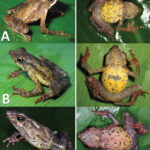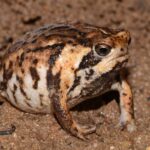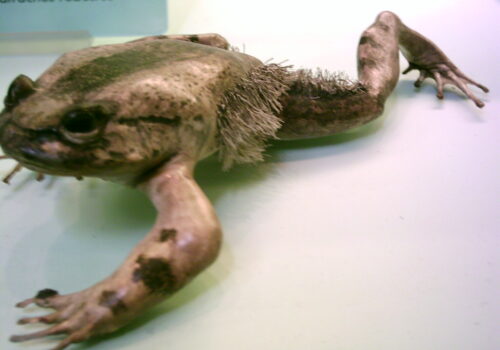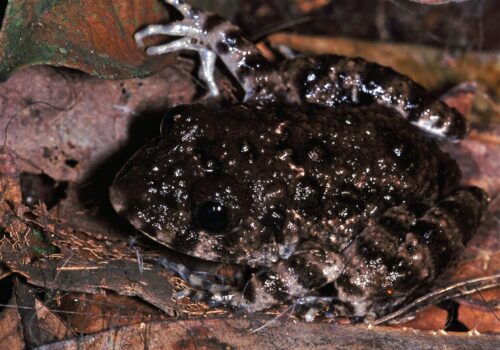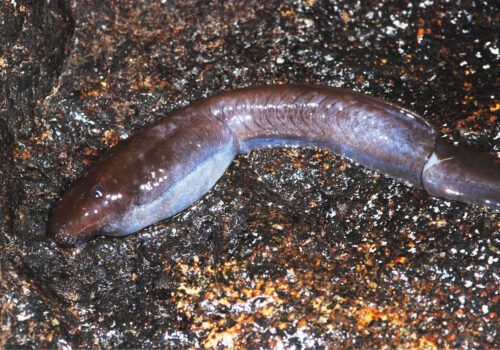- Meet Arthroleptis nguruensis: The Secretive Jewel of Tanzania’s Forest Floor
- Taxonomy and Classification
- Natural Habitat: The Misty Heights of the Nguru Mountains
- Physical Characteristics: Mastering the Art of Concealment
- Behavior and Life Cycle: The Silent Lives Among the Leaf Litter
- Ecological Role: Guardians of Forest Equilibrium
- Threats and Conservation Status: Preserving an Amphibian Treasure
- Cultural and Scientific Significance
- Conclusion: Caring for Earth’s Hidden Marvels
Meet Arthroleptis nguruensis: The Secretive Jewel of Tanzania’s Forest Floor#
Hidden in the lush, mist-draped mountain forests of Tanzania thrives an extraordinary amphibian that most eyes rarely glimpse—the Arthroleptis nguruensis, a small terrestrial frog with fascinating adaptations, cryptic behaviors, and a remarkable ecological story. A member of the Arthroleptidae family commonly known as squeaker frogs, this diminutive creature blends seamlessly with leaf litter underfoot. With its small stature, unique vocalization, and elusive nature, Arthroleptis nguruensis embodies the secret beauty and biodiversity of East Africa’s high-elevation rainforests.
Discovered barely over 15 years ago in the Nguru Mountains of Tanzania, the Nguru squeaker frog’s recent entry into scientific knowledge underlines both the great diversity still hiding unknown in remote natural areas and the urgent need for conserving such pristine ecosystems. Join me as we unveil the secrets, explore the ecosystem this frog inhabits, understand its delicate biology, and grasp the significance of protecting such cryptic yet vital species.
Taxonomy and Classification#
To fully appreciate the uniqueness of Arthroleptis nguruensis, let’s first place it within its scientific context. Taxonomically positioned within the Arthroleptidae family, Arthroleptis nguruensis belongs to the genus Arthroleptis—a genus of frogs famous among researchers for their direct-developing lifecycle and distinct vocalizations. Within this genus, several species share similar characteristics, yet each member holds distinctions in habitat, morphology, vocalization patterns, and life strategies that set them apart.
Scientifically described and formally introduced to the world in 2009 by herpetologists Blackburn, Menegon, Loader, and colleagues, Arthroleptis nguruensis has been recognized as an independent species due to its genetic makeup, distinct calls, and subtle morphological features. Close relatives such as Arthroleptis xenodactyloides and Arthroleptis stenodactylus coexist within East Africa, highlighting the remarkable biodiversity that characterizes the region. Yet it is the Nguru Mountains’ very isolation—a geographic barrier—that played a pivotal role in shaping the unique evolutionary path of Arthroleptis nguruensis, underscoring its distinctive identity.
Natural Habitat: The Misty Heights of the Nguru Mountains#
The secretive Arthroleptis nguruensis finds its refuge in the misty cloud forests of the Tanzania Eastern Arc Mountains—a biodiversity hotspot recognized globally for its extraordinary species richness and high levels of endemism. Specifically, this frog inhabits montane forests at elevations ranging generally between 1200 to 2000 meters above sea level in the Nguru range, one of the less-explored territories within Tanzania’s Eastern Arc chain.
These mountain forests provide an environment ideal for the amphibian lifestyle—cool microclimates, abundant precipitation, rich vegetation cover, and layers of leaf litter that ensure moisture retention. Arthroleptis nguruensis resides predominantly among the leaf litter and low vegetation of dense forest floors, relying heavily on its camouflage and secretive lifestyle to survive undetected by predators and researchers alike. The damp litter creates a microhabitat teeming with emerging insects, small invertebrates, and other potential prey items—ensuring steady sustenance essential for the frog’s survival.
Within this enveloping greenery, darting sunlight occasionally illuminates patches of moss-covered logs and richly decaying vegetation—idyllic hideaways for Arthroleptis nguruensis. These miniature worlds not only provide them consistent climatic and moisture conditions but also safeguard them from their natural predators, mainly snakes and birds. The presence of Arthroleptis nguruensis, sensitive as it is, acts as an invaluable indicator of forest health and ecological integrity.
Physical Characteristics: Mastering the Art of Concealment#
At first glance, some might dismiss Arthroleptis nguruensis as just “another small brown frog,” but closer inspection reveals an exquisitely adapted natural wonder. Adult individuals are relatively small, typically ranging from 20 to 25 millimeters in length. Their robust bodies, streamlined for a terrestrial lifestyle, are supported by short, muscular limbs that enable swift jumps and agile, discreet movements within dense forest foliage.
This species’ skin displays various shades of earthy browns, tans, and olive greens, intricately speckled with darker and lighter patterns. These hues harmonize remarkably well with their leaf-litter habitat, rendering Arthroleptis nguruensis virtually invisible to the casual observer. This cryptic coloration is precisely designed by evolutionary processes to evade detection by predators and prey alike—a perfect example of natural camouflage employed to perfection.
Beyond coloration, Arthroleptis nguruensis possesses notable physical attributes adapted uniquely for its ecological niche. A characteristically narrow head bears disproportionately large eyes—a trait suggesting nocturnal or crepuscular habits. Slender, agile fingers and toes tipped with tiny discs give the frog a delicate yet assured grip on wet foliage and slippery surfaces, a vital asset in their dense habitat.
Behavior and Life Cycle: The Silent Lives Among the Leaf Litter#
Understanding Arthroleptis nguruensis’ behavior provides vivid insights into its fascinating natural history. Like many other species in the Arthroleptidae family, this frog follows direct development, skipping the aquatic tadpole stage entirely. Females lay their eggs in concealed, damp locations among leaf litter and decaying vegetation. Eggs hatch directly into fully formed miniature froglets, perfectly adapted for terrestrial life and immediately capable of embarking on their cryptic, independent lives.
The evolutionary advantage of direct development cannot be overstated, especially for montane forest frogs where standing water bodies can be sparse or seasonal. This reproductive strategy removes dependence on water sources, a significant evolutionary adaptation allowing Arthroleptis nguruensis to flourish within distinct montane microhabitats that might otherwise limit its presence.
Vocalizations: Quiet Calls Within the Mist#
Arthroleptis nguruensis communicates through high-pitched, birdlike whistles, earning its genus the affectionate nickname “squeaker frogs.” These vocalizations—often described as “clicks” or short, sharp whistles—are subtle compared to louder amphibians found in warmer lowland environments. Despite this subtlety, these calls serve effectively for mate attraction and territorial communication, essential within dense foliage where visual cues falter. From dusk till dawn, and especially after periods of rainfall, the Nguru forest comes alive with the delicate, intermittent calls of these little frogs, blending harmoniously within the natural symphony.
Ecological Role: Guardians of Forest Equilibrium#
Every organism plays its part within complex ecosystems, and Arthroleptis nguruensis is no exception. Their predation on insects keeps pest populations manageable, indirectly supporting forest plant life. Conversely, they themselves are prey to snakes, birds, rodents, and—often overlooked—various arthropods, ensuring a robust, interconnected food web.
Moreover, the presence and relative abundance of Arthroleptis nguruensis reflect the overall health of the montane forest ecosystem. Due to their skin’s permeability and their particular sensitivity to environmental changes, amphibians like Arthroleptis nguruensis act as critical biological indicators. Changes in population dynamics or distribution may well signal underlying environmental shifts, alerting conservationists to potential problems.
Threats and Conservation Status: Preserving an Amphibian Treasure#
While precise population data remains limited, the relatively restricted geographic range and specialized habitat preferences of Arthroleptis nguruensis raise conservation concerns. Habitat loss through logging, agriculture, and human encroachment represents a severe threat. Climate change, manifesting in altered rainfall patterns, temperature fluctuations, and circulation of amphibian diseases, poses additional stressors.
Currently classified as “Critically Endangered” on the IUCN Red List, Arthroleptis nguruensis underscores an urgency in implementing robust conservation initiatives. Efforts already underway include local projects aimed at raising awareness about the value of Tanzania’s montane forests, strengthening protected-area enforcement, and running ecological monitoring programs to inform effective future conservation strategies.
Cultural and Scientific Significance#
Though Arthroleptis nguruensis may not play a prominent role in human folklore or culture, its discovery offers critical lessons about biodiversity, adaptation, and environmental change. Each new species we uncover enhances our understanding of evolutionary biology and ecosystem resilience. As the guardians of ecological clues, frogs like Arthroleptis nguruensis tell us more about climate conditions, ecosystem health, and the hidden consequences of environmental vandalism.
Conclusion: Caring for Earth’s Hidden Marvels#
In appreciating Arthroleptis nguruensis, we find hidden beauty and scientific insight among Tanzania’s mist-shrouded forests. Advocating for its protection means safeguarding countless other species dependent on these delicate ecosystems. Let us recognize, cherish, and protect these hidden marvels, ensuring they can continue their silent yet significant existence for generations to come.


